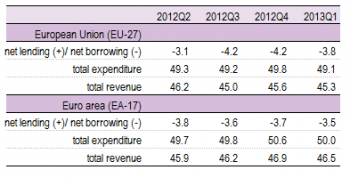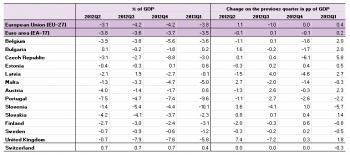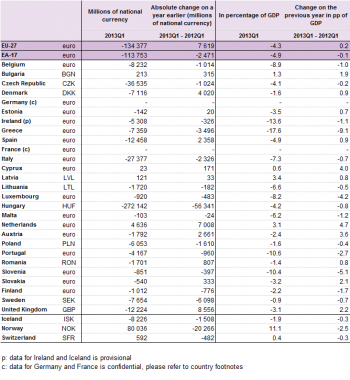Archive:General government deficit - quarterly data
In the first quarter of 2013, euro area and EU-27 seasonally adjusted government deficits decrease
Statistics in focus 21/2013; Authors: Luca ASCOLI, Martim ASSUNÇÃO, Cristina CALIZZANI, Laurent FREYSSON, Laura WAHRIG
ISSN:2314-9647 Catalogue number:KS-SF-13-021-EN-N
This article is outdated and has been archived. For recent articles on Government finance, please see here,
Eurostat regularly publishes seasonally adjusted and working day adjusted quarterly data on government revenue , expenditure and surplus (+)/deficit (-), currently for thirteen Member States and the EU aggregates. This publication is based on data transmitted to Eurostat at the end of June 2013 and includes data coverage of the first quarter of 2013.




Main statistical findings
In the first quarter of 2013, the seasonally adjusted general government deficit to GDP ratio was -3.5 % in the euro area (EA-17) and -3.8 % in the European Union (EU-27). In the previous quarter it was -3.7 % in the EA-17 and -4.2 % in the EU-27. In 2013Q1 EA-17 and EU-27 general government total revenue amounted to 46.5 % and 45.3 % of GDP respectively, while total expenditure amounted to 50.0 % and 49.1 % of GDP.
Quarterly trends in government deficit
The differing evolution of the EA-17 and EU-27 in 2012Q2 and the corresponding quarter-on-quarter growth rates are largely due to a one-off event in the United Kingdom. The nationalisation of the Royal Mail pension scheme and corresponding assumption of assets in 2012Q2, recorded as a capital transfer to the general government sector, had a positive impact of about 30 billion GBP on the EU-27 total, which explains the largest part of the temporary decrease in the EU-27 government deficit in 2012Q2. The 2012Q4 Belgian net lending (+)/ net borrowing (-) is negatively influenced by a bank recapitalisation. The 2012Q4 deficit for the Czech Republic is negatively influenced by a capital transfer in the context of the church restitution. For Portugal, the quarterly variations in the seasonally adjusted net lending (+)/ net borrowing (-) during 2012 and 2013Q1 are largely due to one-off operations. The large quarter-on-quarter increase in net borrowing in Slovenia in 2013Q1 is due to a capital injection treated as capital transfer to a bank.
Fourteen countries publish seasonally adjusted deficit data
Quarterly non-financial accounts for general government are published for 27 Member States as well as three EFTA countries. For Germany and France, certain transactions, including net lending (+)/net borrowing (-) are under embargo until all quarters of the current year are available.
When using non-adjusted data, quarter-on-quarter growth rates should not be used and comparison between countries should be avoided, as the pattern of seasonality can differ significantly between countries.
Thus, year-on-year growth rates are used in table 3. These are influenced both by events in the quarter of the previous year and the current year's quarter.
It should also be noted that annualised seasonally adjusted data is not in general equal to annualised non-adjusted data. When using annualised figures, it is more appropriate to use non-seasonally adjusted data. Using seasonally adjusted data is more appropriate when looking at quarter-on-quarter growth rates.
Data sources and availability
Quarterly accounts of general government
Eurostat releases quarterly flow and stock data for the general government sector, using an integrated structure which combines the data from quarterly non-financial accounts for general government (QNFAGG), quarterly financial accounts for general government (QFAGG) and quarterly government debt (QGD). An integrated publication combining data from all three tables is released quarterly on the dedicated Government Finance Statistics (GFS) section of the Eurostat web site. The regulations on these three data flows are available on the Eurostat web site in the section dedicated to government statistics.
ESA95
Fiscal non-financial and financial accounts data are compiled in accordance with national accounts rules, as laid down in the 1995 European System of Accounts (ESA95) adopted in the form of a Regulation 2223/96of 25 June 1996. The full text of ESA95 is available on the Eurostat web site.
Quarterly non-financial accounts for general government (QNFAGG)
The aim of QNFAGG is to compile, report and present quarterly government expenditure, revenue and their components. Government revenue and expenditure are concepts used to analyse fiscal policy. Total revenue and total expenditure are defined in ways such that the ESA95 government net lending (+)/ net borrowing (-) (ESA95 B.9), is equal to the difference between the former and the latter.
Government quarterly revenue and expenditure, and their components, are reported in the framework of the Regulation 1221/2002 on quarterly non-financial accounts for general government (QNFAGG).
In this publication the definition of net lending (+)/ net borrowing (-), also referred to as surplus (+)/ deficit (-) is applied as defined in Regulation No 2223/96 of 25 June 1996 on the European system of national and regional accounts in the Community. This definition differs slightly from the one used for the purposes of the Excessive Deficit Procedure, which treats swaps and forwards non-financial transactions. In the definition used here, these are treated as financial transactions and thus do not impact the deficit. For most countries and the EU aggregates, the difference between the two measures is small.
General government
QNFAGG and QFAGG statistics cover data for general government.According to ESA95, paragraph 2.68 "the sector general government (S.13) includes all institutional units which are other non-market producers [institutional units whose sales do not cover more than the 50 % of the production costs, see ESA95 paragraph 3.26] whose output is intended for individual and collective consumption, and mainly financed by compulsory payments made by units belonging to other sectors and/or all institutional units principally engaged in the redistribution of national income and wealth".
Seasonal adjustment of selected data series
Quarterly government finance statistics are reported to Eurostat in the form of non-seasonally adjusted (raw) figures. However, a certain number of the reported series contain seasonal patterns (partly explained by the link with the seasonality of economic activity and by the budgetary planning and accounting practices of national governments), which make it difficult to carry out a direct meaningful cross-country and time series analysis. The same is true for GDP, which reflects the seasonal pattern of all economic activities in the economy.
To overcome this difficulty and thus to gain a better understanding of trends in addition to the non-seasonally adjusted data, seasonally adjusted data is presented for the EU-27 in this article. The seasonal adjustment for total revenue and total expenditure is done using an indirect procedure (at country level mainly using Tramo-Seats in Demetra+).
Where available, National Statistical Institutes own estimates are used as input for the aggregates, which are supplied to Eurostat on a gentlemen's agreement basis. Some country level estimates as well as data for the EU aggregates are published on Eurobase as well as presented in this publication. These estimates are supplemented by Eurostat's own estimates for those countries which do not yet supply their own estimate. This data is labelled confidential and not published.
Net lending (+)/ net borrowing (-) is derived indirectly from the accounting identity: Net lending (+)/ net borrowing (-) = total revenue - total expenditure.
As concerns GDP, no independent estimate is derived. The results of the seasonal adjustment are subject to further tests and might be revised in the future.
Metadata of the seasonal adjustment can also be found in the QNFAGG metadata file on Eurobase.
For the following countries, the estimates are produced by the respective National Statistical Institute, which all follow the “ESS guidelines on seasonal adjustment”:
BE: The seasonally adjusted series are computed following an indirect approach. The components of the revenue and of the expenditure of the General Government are seasonally adjusted by means of "Tramo-Seats", taking into account the presence of possible outliers and calendar effects. The model of each component (>20) has been individually validated (no automatic modelling). The absence of residual seasonality after aggregation has been checked. The data are benchmarked on annual totals of the non-adjusted series. The annual benchmarking is computed on each component by means of a multiplicative Denton procedure.
BG: Tramo-Seats on Demetra + Total expenditure: No trading days effects, no Easter effect, ARIMA model [(0,1,1)(0,1,1)], outliers: AO[2007-IV], TC[2008-IV], AO[2009-I]. Total revenue: Log-transformation. No trading days effects, no Easter effect, ARIMA model [(0,1,0)(1,1,0)], outlier: LS[2007-I].
CZ: Tramo-Seats on Demetra + Total expenditure: No trading days effects, no Easter effect, ARIMA model [(0,1,1)(0,1,1)], outliers: AO[2003-I], AO[2003-III], AO[2012-IV], TC[2001-IV]. Total revenue: No trading days effects, no Easter effect, ARIMA model [(1,1,0)(0,1,1)], outliers: AO[2003-I], TC[2007-III], AO[2008-III].
EE: Tramo-Seats on Demetra + Total expenditure: Trading days effects (1 variable), no Easter effect, ARIMA model [(0,1,0)(0,1,1)], AO[2008-IV]. Total revenue: No trading days effects, no Easter effect, ARIMA model [(1,1,0)(0,1,0)], outliers: AO[2009-IV].
LV: Tramo-Seats on Demetra + Total expenditure: Log-transformation, no trading days effects, no Easter effect, ARIMA model [(0,1,1)(0,1,1)], outliers: LS[2009-III], LS[2006-IV], LS[2005-IV]. Total revenue: Log-transformation, no trading days effects, no Easter effect, ARIMA model [(0,1,0)(0,1,1)], outlier: LS[2008-IV].
MT: Total expenditure: Tramo-Seats on Demetra+, no trading days effects, no Easter effects, ARIMA model [(0,1,1)(0,1,1)], Detected outliers: AO[2003-IV]. Total revenue: Tramo-Seats on Demetra+, no trading days effects, no Easter effects, ARIMA model [(0,0,0)(0,1,1)], Detected outliers: LS[2008-IV].
AT: Tramo-Seats on Demetra + Total expenditure: no trading days effects, no Easter effect, ARIMA model [(0,1,1)(0,1,1)], outliers: AO[2004-IV]. Total revenue: Log-transformation, no trading days effects, no Easter effect, ARIMA model [(0,1,1)(0,1,0)], outlier: LS[2009-I].
PT: X13-ARIMA on Demetra+. A manual pre-treatment is performed by identifying and deducting one-off measures. Additional pretreatment is applied for outlier detection and correction. The seasonal adjustment is applied to total revenue, expenditure except compensation of employees and compensation of employees. Total revenue: no trading day effect; no Easter effect; ARIMA model [(011)(011)]; outliers: AO[2003 IV], AO[2004 IV]. Expenditure except compensation of employees: no trading day effect; no Easter effect; ARIMA model [(001)(011)]; outliers: AO[2002 III], AO[2002 IV], AO[2009 III], LS[2012 I]. Compensation of employees: no trading day effect; no Easter effect; ARIMA model [(011)(011)]; outliers: SO[2012 II IV].
SI: Model for total revenue: Log transformation, 6 variables for trading days effects, Slovenia holidays, Easter effect (6 days), no outliers, ARIMA(0,1,0)(0,1,1) model. Model for total expenditure: Log-transformation, no trading days effects, no Easter effect, 3 prespecified outliers (AO[2001-I], AO[2011-I], (AO[2012-II]), 1 detected outlier (AO[2013-I]), ARIMA(0,1,0)(0,1,1) model.
SK: Tramo-Seats on Demetra + Total expenditure: no trading days effects, Easter effect (4 days), ARIMA model [(1,0,0)(0,1,0)], outliers: LS[2000-IV], AO[2002-IV]. Total revenue: Log-transformation, no trading days effects, no Easter effect, ARIMA model [(0,1,0)(0,1,1)].
FI: Tramo-Seats on Demetra 2.2. Pre-treatment is done if necessary, for example for outlier detection and correction. Total revenue and expenditure are estimated indirectly on the basis of their components and on sub-sector data.
SE: Tramo-Seats on Demetra + Total expenditure: Log-transformation, no trading days effects, no Easter effect, ARIMA model [(0,1,0)(0,1,1)], no outliers. Total revenue: Log-transformation, no trading days effects, no Easter effect, ARIMA model [(1,0,0)(0,1,0)], outlier: LS[2009-I].
UK: Adjustment using X-11 algorithm in X-13ARIMA-SEATS. Net borrowing: No trading day effects, no Easter effect, ARIMA model [(0,1,1)(0,1,1)], outliers: AO[2000Q2], AO[2000Q3], AO[2005Q2], AO[2012Q2], seasonal moving average: 3x5, trend moving average: 5. Total expenditure: No trading day effects, no Easter effects, ARIMA model[(0,1,1)(0,1,1)], outliers: AO[2000Q2], AO[2000Q3], AO[2005Q2], AO[2008Q3], seasonal moving average: 3x3, trend moving average: 5. Total revenue: Log-transformation, no trading day effects, no Easter effects, ARIMA model[(0,1,1)(0,1,1)], outliers: AO[2008Q3], AO[2012Q2], seasonal moving average: 3x5, trend moving average: 5. For the purpose of calculation the EU aggregates, B.9 is derived indirectly.
CH: The data reported is trend-cycle data. A Denton-Cholette method is used to temporally disaggregate annual data. The quarterly data is extrapolated using smoothed indicators.
Revision policies/ country notes
The differing revision policies of EU Member States and EFTA countries reporting quarterly GFS data can be viewed in the QNFAGG manual as well as in the metadata file on Eurobase. Revisions are generally accepted by Eurostat.
The majority of countries revise quarterly QNFAGG data once more detailed sources used for the compilation of annual general government accounts become available; that is with the provision of quarterly data for the fourth quarter.
IE: Data is provisional. In particular, revisions to the structure of tax revenue are expected for all but the most recent quarter. The balancing between non-financial and financial accounts is under discussion between CSO Ireland and Eurostat.
EL: The recording of receipts of MEUR 81 relating to the International Broadcasting Centre as K.2 in 2013Q1 is only considered as provisional until the on-going methodological discussion on its treatment is concluded.
CY: Eurostat and CYSTAT mutually agree to provisionally classify the signature bonus payments related to fossil fuel exploration contracts in the Cypriot EEZ as K.2 in 2013Q1 until the methodological discussion on its treatment is concluded.
NL: The Dutch government nationalised the financial corporation SNS REAAL on 1 February. 2013. The capital injections by the Dutch government into SNS REAAL (billion EUR 2.2) are provisionally recorded as financial transactions (AF.5) in 2013Q1.
AT: Due to a change in the structure of the federal budget, the 2013Q1 data for compensation of employees and the tax aggregates is to be considered as provisional and could be revised.
IS: Data is provisional.
Please refer to the Country notes on EMIS (ESMS metadata file — gov_q_ggnfa_esms) for more important information at country level.
Gross domestic product
Throughout this publication, gross domestic product (GDP) at current prices (nominal) is used, either using the non-seasonally adjusted or the seasonally and working-day adjusted forms as appropriate.
Context
Eurostat regularly publishes seasonally adjusted and working day adjusted quarterly data on government revenue, expenditure and surplus (+)/deficit (-), currently for thirteen Member States and the EU aggregates. This article is based on data transmitted to Eurostat at the end of June 2013 and includes data coverage of the first quarter of 2013.
See also
Further Eurostat information
Publications
- In the first quarter of 2013, euro area and EU-27 seasonally adjusted government deficits decrease Statistics in focus 21/2013
Main tables
- Government statistics (t_gov)
- Quarterly government finance statistics (t_gov_q)
Database
- Government statistics (gov)
- Quarterly government finance statistics (gov_q)
- Quarterly non-financial accounts for general government (gov_q_ggnfa)
- Quarterly government finance statistics (gov_q)
Dedicated section
Methodology / Metadata
- Quarterly non-financial accounts for general government (ESMS metadata file — gov_q_ggnfa_esms)
Other information